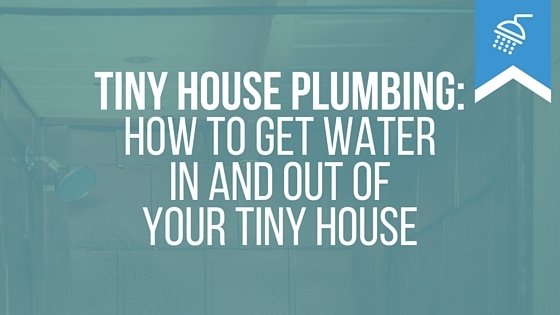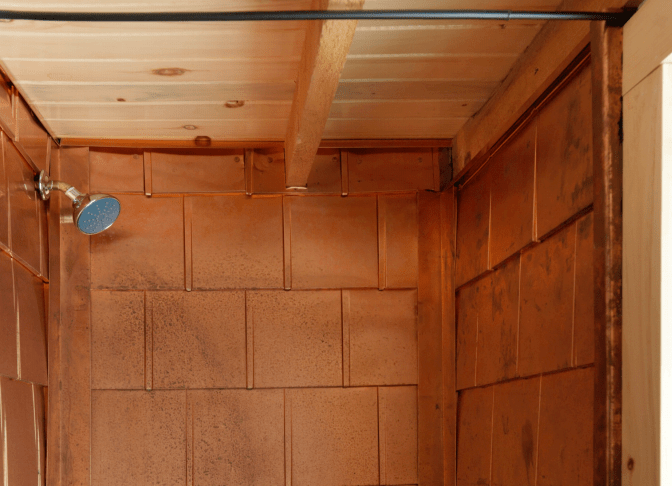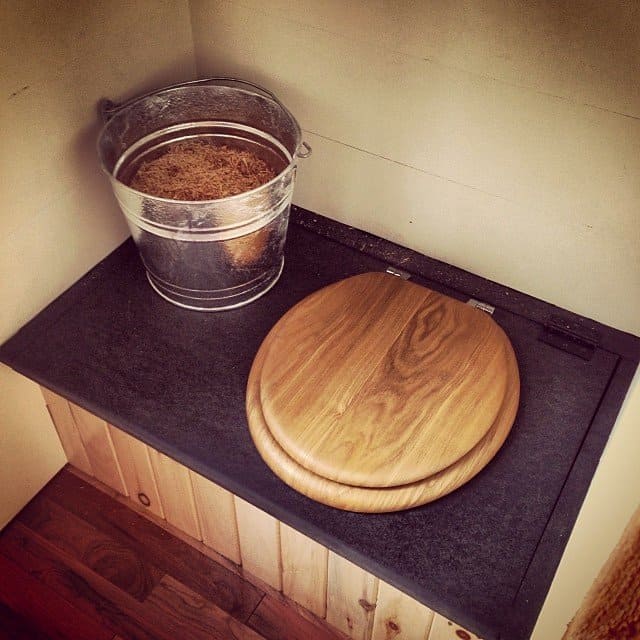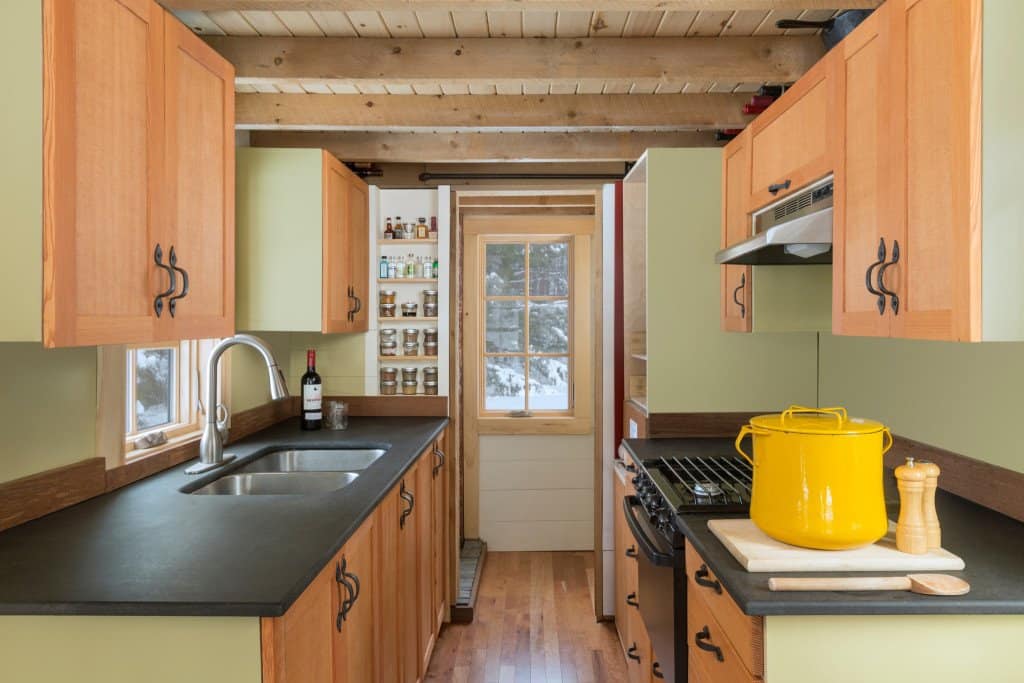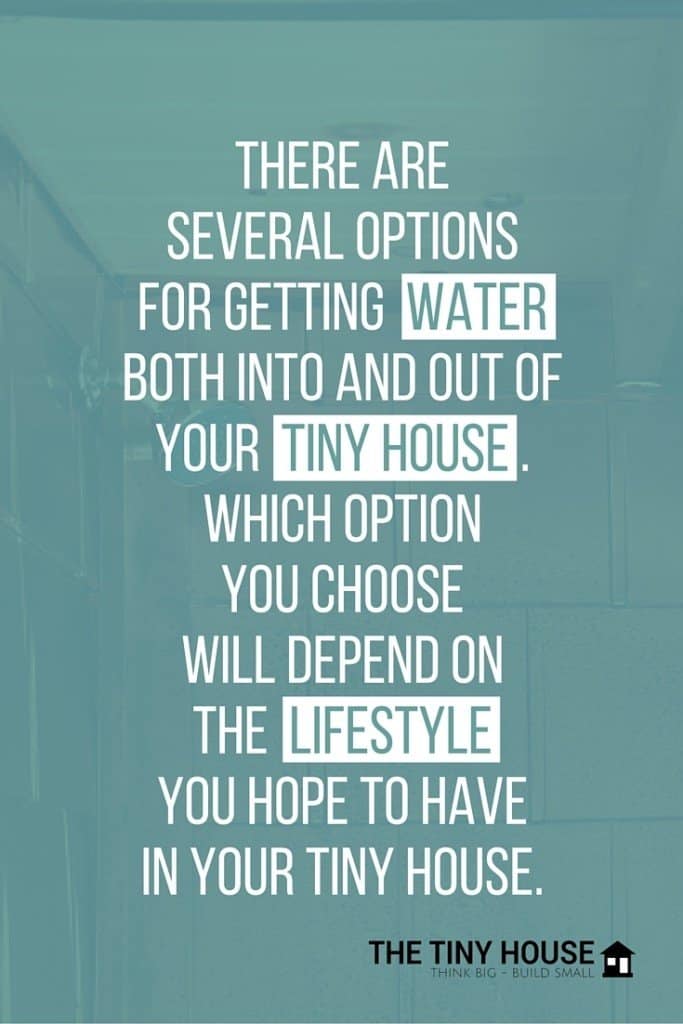One of the parts of building a tiny house that many people worry about is tiny house plumbing. This is one big area where your tiny house will be very different from a regular house. While normal houses generally have permanent access to water because they're on the grid, when your house is mobile, there's no guarantee that you'll always be near to a water source that you can hook up to. And while stages of the build like choosing a trailer and sourcing salvaged materials seem exciting and manageable, things start to feel a little scarier when it comes to getting water in and out of your tiny house. Don't you need to be a trained plumber to do that? The good news is that there are several options for getting water both into and out of your tiny house. Which option(s) you choose will depend on the lifestyle you hope to have in your tiny house. Before you make your decision, it's important that you understand the pros and cons of each tiny house plumbing options. In this article, I'll outline the different possibilities. For more details about the trade-offs that come with each option, make sure to consult Tiny House Decisions.
How to Get Water into Your Tiny House Bathroom
First up, let's look at the different ways to get water into your tiny house.
No Plumbing
The easiest option is clearly to have no plumbing system at all. This doesn't mean you can't have water in your tiny house, but it does make things a lot less automatic! If you choose this option, you're basically signing up to carry any water you need to use into your house. If you do this, you can take different amounts of water to different parts of your tiny house. For example, you might store some near the sink, to pour over any dishes, and you might keep some in the bathroom to create a gravity-fed shower. You're likely to carry the water using buckets, bottles, or jugs, so you'll probably want to park your tiny house close to a water supply, such as someone else's kitchen. This could work well if you were to park your tiny house in someone's backyard or on a campsite. Alternatively, if you're someone who goes to the gym regularly, you could reduce the amount of water you'd need to use (and therefore the amount you'd need to carry) by showering there instead. If you're unable to park near to a water supply, you'll probably need to bulk buy water and find somewhere to store it. Remember that space is at a premium in tiny houses, so this might mean keeping your water outside. Obviously, the main benefit of this option is not having to deal with any of the hassles that come with plumbing. Your tiny house would probably also cost a lot less than most tiny houses. It's up to you whether or not these benefits are worth all the trips you'll need to take to collect water, and the possibility of running out of water.
Tank and Pump
A second and perhaps more practical option is to put a tank into your tiny house and to use a pump to circulate and pressurize the water. This is a great option because it gives you the functionality of a normal house and the option to have a tiny house shower, but it allows you the freedom of living off-grid.
Of course, this option comes with downsides too, but they're all very bearable. Pumps can be a bit noisy when they're in use and tanks take up a fair bit of space. You also have to deal with the matter of deciding which size tank to get. On the one hand, the bigger your tank is, the longer you can go without needing to fill it back up, but, on the other hand, the bigger it is, the more space it takes up and the heavier the load is.
You might worry that having a large tank in your tiny house would create a bit of an eyesore, but there are plenty of ways to hide it. My tank is hidden away under my kitchen cabinets. For more photos and a better idea of what installing a tank looks like, see Jonathan's plumbing series (posts one and two).
Of course, the biggest downside to having a tank only is that you have to fill it! Either by hauling water in jugs and pouring them into the tank, or using a hose through an external fill port like this one. And if you want a flush tiny house toilet, a tank might not be able to hold quite enough water.
Hookup
If you don't plan to ever live off-grid and you'll always have access to a water source such as those you find on campsites, you could choose to simply hook your tiny house up to a regular water supply.
This option just involves installing tiny house plumbing so that your tiny house can accept water through an RV hose. If you go this route, your tiny house bathroom and plumbing system will function like that of any other RV. Here's a photo of my tiny house shower, which I can run from the water in my tank:
Hybrid
What if you want the best of both worlds? Well, it is actually possible to both use a conventional hookup and set up your tiny house to provide you with water should you want to go off-grid for a while. You can install the plumbing you need to accept city water and you can install a tank and a pump. This option prepares you for all eventualities and gives you a lot more flexibility and freedom. If you're staying put, you can simply plug in and forget about water, but if you want to travel for a while, you can get off the beaten path and not worry about finding an alternative water supply. Of course, this tiny house plumbing option involves more work and you do still have to deal with the tank taking up precious space and the pump making a racket, but, if you ask me, those are good tradeoffs for complete flexibility. 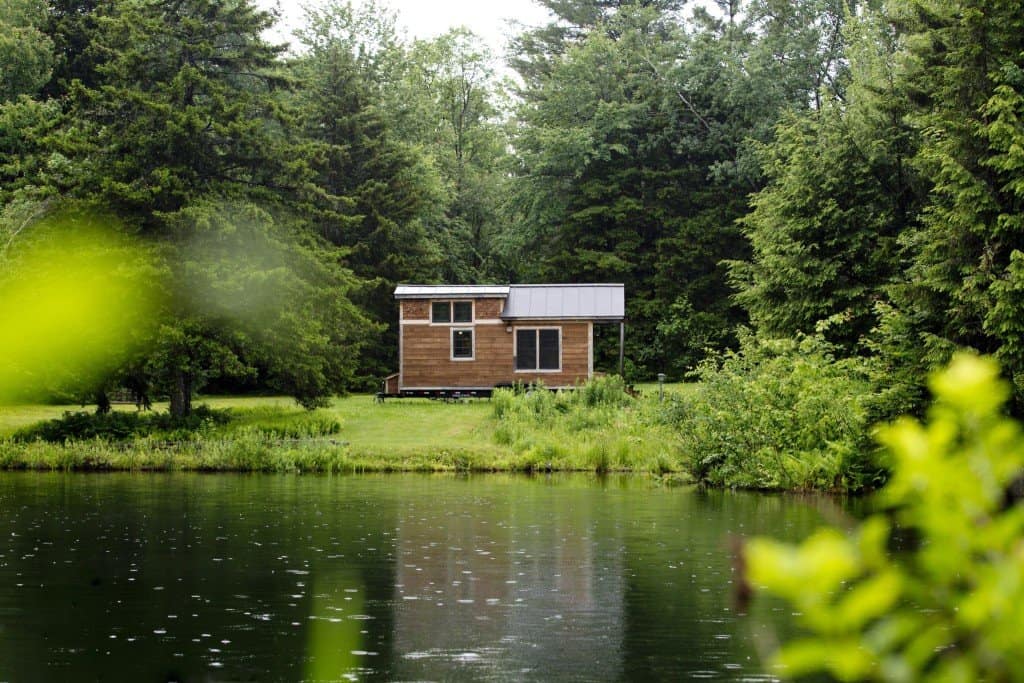
Plumbing Tiny House Drains: How to Get Water out of Your Tiny House
On first thoughts, you might think that getting water out of your tiny house would be fairly simple. Just drain it out through the floor, right? Well, yes and no. The important thing to understand about waste water is that you have to be very careful about where it goes and what it comes into contact with.
The Grid
The simplest solution when it comes to removing waste water from your tiny house is to hook your house up to an existing system. This means a septic system (often in more rural areas) or the public sewer system in more urban areas. This option involves installing a drainage system like the ones stationary houses use and hooking it up to an external system. Of course, this option only works if you're living on-grid, whether that's at a campsite, in someone else's backyard, or on a piece of land. If, at any time, you decide to leave a piece of land that comes with a hookup, you'll be in trouble. 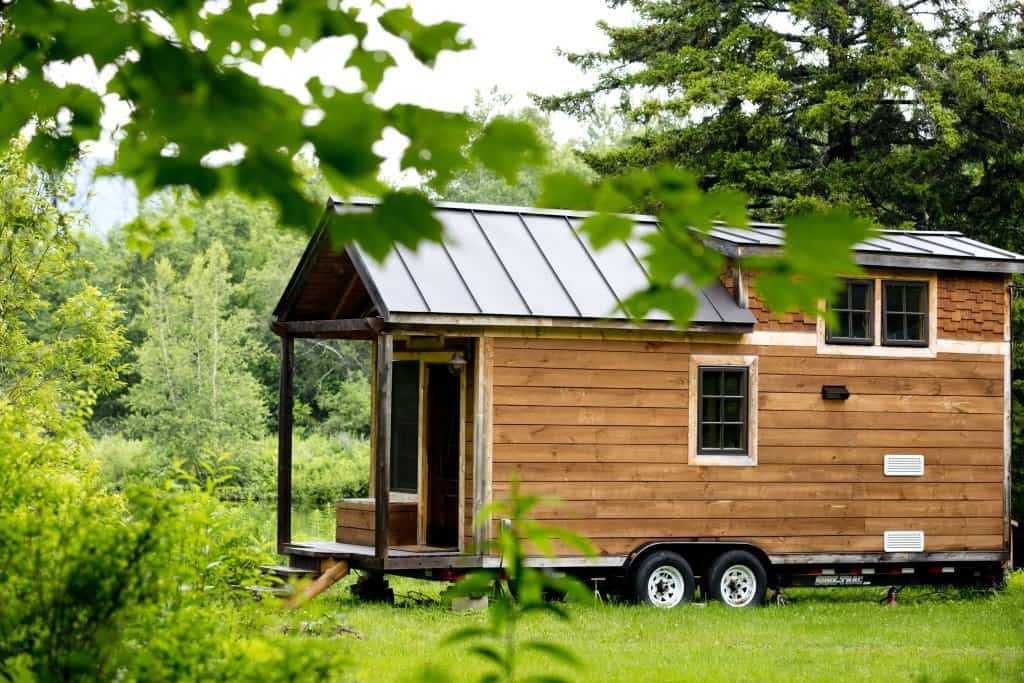
Grey Water Catchment
Another thing to understand about removing water from your tiny house is that there are different kinds of water. Black water is the waste from your tiny house toilet. Storing this kind of water in a mobile home is difficult because of weight restrictions, so I'd recommend using a composting toilet instead of a regular toilet. If you do that, you have one less load of water to deal with. The other type of water is grey water – the waste water from sinks, showers, and washing machines. Grey water is basically any waste water that hasn't come into contact with feces. While you shouldn't release grey water into bodies of water such as lakes, because it would pollute them, it is possible to drain this water into the ground around your tiny house. Trees and plants can filter the water and use it as a fertilizer. The good news about grey water is that it can be pretty simple to drain out of your tiny house. All you have to do is redirect the water to some plants. That said, if you decide you drain your grey water in this way, there are a few things you need to know. For starters, removing grey water like this is not always legal. I've written a whole article about grey water and the different grey water systems you can use, so please read that if you are considering using a grey water system.
Collect and Dump
Another option is to collect your waste water – both grey and black – and to get rid of it at dump stations. You could use a black water holding tank outside of your tiny house and a simple bucket under the sink or shower for grey water. If you went this route, you'd be using the same system that a lot of RVs use. The disadvantages of this approach are quite obvious. Firstly, your tiny house will have to carry some extra weight. You'll have to store dirty and potentially dangerous waste water in your house (ew!). And you'll have to make regular trips to a dump station to offload your waste water. If you have a tiny house shower along with a toilet, this could be a lot of water! This isn't really the most pleasant or convenient option for a tiny house bathroom, but if you're planning to live off-grid and you're not prepared to use a composting toilet, you won't have much choice.
What Is Everyone Else Doing for Tiny House Plumbing?
My Tiny House Plumbing
I opted for a hybrid system. As you saw above, I have a 40-gallon tank in my kitchen, which I fill up using a water hookup. While I live on-grid at the moment, I like knowing that, if I wanted to, I could go off-grid in the future. I'm also very lucky with the piece of land that I live on, because there's a septic tank and the water is spring-fed.
Tammy Strobel and Logan Smith- No Tiny House Shower
Tammy and Logan have a pretty simple plumbing system for their tiny house. Essentially, they have one pipe going in and one pipe going out. Their kitchen sink is hooked up to a hose, though during the winter they often have to carry water in instead because it freezes in the pipe. They drain their grey water through a pipe to a container under their house, and then use that water for the plants outside.

Photo courtesy of Tammy Strobel
Chris and Malissa Tack – Tiny House Shower with Grey Water Catchment System
Chris and Malissa use a 40-gallon tank to store their water in. They let their grey water drain out of their house and run straight onto the rocks outside. If they wanted to, they could place a tank under their house and collect that water instead. You can see photos of their setup here.
Photo courtesy of Chris and Malissa Tack
Laura LaVoie – No Tiny House Plumbing
Laura LaVoie makes use of the spring that's on the land she lives on. She collects the water in large containers, carries it to her house, and treats it using a water filter positioned over the sink. She also buys drinking water by the gallon. As for grey water, she uses an artificial wetland.
Photo courtesy of Laura LaVoie
Which Tiny House Plumbing Option Will You Choose?
Deciding how to get water into and out of your tiny house is an important decision that will depend largely on the kind of lifestyle you hope to live, as well as your reasons for going tiny. As well as the pros and cons mentioned above, you'll also need to think about heat, both in terms of the temperature where you live and the temperature you'd like your water to be. If you live somewhere that gets cold in winter, you'll need to consider how to prevent water from freezing, and, wherever you live, you'll have to decide if or how you want to heat the water you use. These are topics for another day (or sooner, if you read Tiny House Decisions!). For now, I'd love to know which approaches to getting water in and out of your tiny house you think will work best for you.

